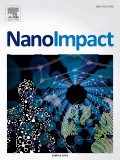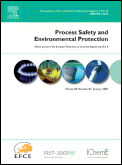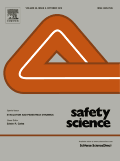
NanoImpact
metrics 2024
Illuminating Nanotechnology's Role in Public Health and Safety
Introduction
NanoImpact, published by Elsevier, is a pioneering journal dedicated to advancing the understanding of nanotechnology's impact across various fields such as materials science, public health, environmental safety, and risk management. Launched in 2016, the journal has quickly established itself as a premier outlet for high-quality research, evidenced by its top-tier quartile placements in several categories, including Q1 rankings in Materials Science (Miscellaneous) and Public Health as of 2023. With a significant Scopus ranking, including #34 in Public Health and #12 in Safety, Risk, Reliability, and Quality, NanoImpact aims to foster interdisciplinary collaboration and innovation among researchers and practitioners. As an invaluable resource for both emerging scholars and seasoned professionals, the journal encourages the exploration of both the beneficial and adverse effects of nanomaterials, bridging the gap between scientific inquiry and real-world applications. Access to cutting-edge research insights through this publication is crucial for anyone invested in the future of technology and its societal implications.
Metrics 2024
 0.88
0.88 4.70
4.70 4.40
4.40 46
46Metrics History
Rank 2024
Scopus
IF (Web Of Science)
JCI (Web Of Science)
Quartile History
Similar Journals

PROCESS SAFETY AND ENVIRONMENTAL PROTECTION
Unraveling the complexities of risk and reliability in engineering.PROCESS SAFETY AND ENVIRONMENTAL PROTECTION, published by Elsevier, is a premier academic journal dedicated to advancing the fields of chemical engineering, environmental science, and safety management. With an impressive impact factor, this esteemed journal undergoes a meticulous peer-review process and serves as a vital platform for researchers, professionals, and students seeking to disseminate cutting-edge research and innovative practices. Submissions are welcome in a wide scope of topics related to safety, risk, reliability, and environmental engineering, demonstrating its influence as a Q1 journal across multiple categories, including Environmental Chemistry and Safety, Risk, Reliability and Quality. By providing a rigorous analysis of current challenges and solutions in the domain since its inception in 1990, it continues to foster interdisciplinary collaboration and practical applications in the United Kingdom and beyond. With the journal not currently offering Open Access options, subscribers gain exclusive access to pivotal insights that shape industry standards and drive advancements in sustainable practices.

Journal of Health and Safety at Work
Innovating practices for a safer work environment.The Journal of Health and Safety at Work, published by the Iranian Occupational Health Association, is a vital resource for researchers, professionals, and students engaged in the fields of occupational health, safety, and environmental management. With an ISSN of 2251-807X and E-ISSN 2383-2088, this Open Access journal has been dedicated to disseminating knowledge since 2012, ensuring that critical research is accessible to a global audience. The journal’s scope encompasses a diverse range of topics including human factors and ergonomics, safety research, and public health, with a focus on enhancing workplace safety and environmental standards. Although currently positioned in the Q4 category across various disciplines within safety and health research, the journal offers a unique platform for emerging studies and innovative practices, making it a significant contributor to the discourse in these fields. The journal's commitment to open access aligns with the growing trend of transparent scholarship, thus facilitating the sharing of vital insights to improve workplace health and safety outcomes. Researchers aiming to publish groundbreaking studies in this pivotal area will find the Journal of Health and Safety at Work an indispensable avenue for advancing knowledge and fostering professional collaboration.

SAFETY SCIENCE
Advancing safety knowledge for a resilient future.SAFETY SCIENCE, published by Elsevier in the Netherlands, is a premier international journal dedicated to advancing the fields of safety research, public health, environmental and occupational health, and risk management. With an impressive impact factor and recognized as a Q1 journal in multiple categories for 2023, its rigorous peer-reviewed articles are essential for researchers, professionals, and students alike. The journal covers a wide range of topics designed to influence safety practices and policies globally. Although Open Access options are not available, the substantial insights provided in each issue underscore the journal's critical role in enhancing the understanding of safety and risk dynamics in a constantly evolving world. With a convergence of knowledge from the years 1991 to 2025, SAFETY SCIENCE remains at the forefront of evidence-based research, stimulating essential dialogues and innovations that shape our approach to safety in various domains.

Toxin Reviews
Pioneering Insights in Toxicology Since 1982Toxin Reviews is a premier academic journal focused on the critical field of Toxicology, published by Taylor & Francis Inc. Established with an aim to foster research and disseminate knowledge, this journal has been pivotal since its inception in 1982 and continues to be a leading platform for both emerging and established researchers. With an impressive impact factor and ranked in the 75th percentile among its peers in the Scopus categories, it serves as an essential resource for scientists, practitioners, and students interested in understanding the complexities of toxins and their effects on health. The journal provides an Open Access platform, enhancing visibility and accessibility of research findings to a broader audience. Covering a wide scope, Toxin Reviews plays a vital role in bridging gaps between toxicological research and practical applications, ensuring that rigorous scientific inquiry translates into real-world solutions.

Toxicological Research
Advancing toxicological knowledge for a safer tomorrow.Toxicological Research is a prominent academic journal dedicated to advancing the field of toxicology through rigorous exploration and innovative research. Published by the Korean Society of Toxicology, this journal serves as a vital resource for researchers, professionals, and students engaged in environmental science, pharmacology, and toxicology. With an ISSN of 1976-8257 and an E-ISSN of 2234-2753, Toxicological Research highlights significant findings and discussions in the realm of health, toxicology, and mutagenesis. Although not an open-access journal, it maintains a solid reputation as evidenced by its Q3 ranking in both health-related toxicology and general toxicology categories for 2023. The journal covers a broad spectrum of topics from fundamental research to applied toxicology and provides a unique platform for the dissemination of knowledge in a field that is increasingly relevant in today’s society. With an anticipated convergence period from 2008 to 2024, Toxicological Research continues to contribute vital insights to understanding the implications of toxic substances on health and the environment.

World Mycotoxin Journal
Innovating solutions for mycotoxin-related health risks.The World Mycotoxin Journal, published by Wageningen Academic Publishers, stands at the forefront of research in the field of mycotoxins, drawing particular attention to their implications in food science, public health, and environmental safety. With an ISSN of 1875-0710 and an E-ISSN of 1875-0796, this journal has continuously contributed to advancing knowledge since its inception and will remain a vital source of information through 2024. Ranked in Q2 within Food Science and achieving notable positions in Public Health and Toxicology, it offers an impactful forum for scholars and professionals worldwide. The journal’s Scopus rankings reflect its importance, with Public Health receiving a 68th percentile ranking, further underscoring the relevance of mycotoxin research in mitigating health risks. Researchers and students alike will benefit from its rigorous peer-reviewed articles, providing access to cutting-edge studies and overviews that address the complexities of mycotoxins and their far-reaching effects.

ECOTOXICOLOGY AND ENVIRONMENTAL SAFETY
Elevating standards in ecotoxicology and public health research.ECOTOXICOLOGY AND ENVIRONMENTAL SAFETY, published by Academic Press Inc. Elsevier Science, stands as a premier journal in the field of environmental science, specializing in the intricate relationships between toxic substances and ecological systems. With a commendable impact factor and recognized as a Q1 journal in various categories including Health, Toxicology and Mutagenesis, and Public Health, it consistently ranks among the top publications in Scopus, placing it in the 96th percentile for Medicine and Public Health. Established in 1977, this journal addresses critical issues related to environmental safety and pollution, making it an essential resource for researchers, professionals, and students alike. Although it does not offer an open access option, the journal’s commitment to publishing rigorous and impactful research makes it a vital platform for advancing the understanding of ecotoxicological risk assessments and environmental protection strategies. For those dedicated to the intersection of science and public health, ECOTOXICOLOGY AND ENVIRONMENTAL SAFETY serves as a beacon of knowledge and innovative research.

CURRENT SCIENCE
Elevating Knowledge, Inspiring InnovationCURRENT SCIENCE, published by the Indian Academy of Sciences, is a distinguished multidisciplinary journal that has been a cornerstone of scientific literature since its inception in 1945. With an ISSN of 0011-3891, it provides a platform for high-quality research articles that span a wide array of scientific disciplines, reflecting the dynamic landscape of contemporary science. The journal is currently ranked in the Q2 category, demonstrating its significant impact and contribution to the field, as evidenced by its position at Rank #69 out of 171 in the Scopus ranking system, placing it within the 59th percentile among its peers. CURRENT SCIENCE is not only a vital resource for researchers and professionals seeking to stay abreast of advancements but also serves as an educational tool for students across various scientific domains. Although it does not offer open access options, its robust editorial standards and commitment to disseminating noteworthy research make it an essential read for anyone invested in the pursuit of knowledge and innovation. Based in Bangalore, India, the journal continues to engage a global audience, ensuring that cutting-edge scientific discoveries and interdisciplinary dialogues are accessible to the wider scientific community.

Nanotoxicology
Decoding the Risks of Nanomaterials in Biomedical ScienceNanotoxicology is a pioneering journal published by Taylor & Francis Ltd, dedicated to the critical examination of the toxicity of nanomaterials and their implications in biomedical engineering, nanoscience, and toxicology. With an ISSN of 1743-5390 and E-ISSN of 1743-5404, this journal has established itself as a significant player in its field since its inception in 2007. Classified within the Q2 category for 2023 in major categories such as Biomedical Engineering, Nanoscience and Nanotechnology, and Toxicology, it reflects its robust impact across interdisciplinary research. Notably, its Scopus rankings position it in the top percentile, underscoring its influence in pharmacology and toxicology. The journal offers scholars, researchers, and professionals a platform for sharing pioneering studies and reviews, thereby advancing the understanding of nanomaterial interactions with biological systems. Published from the United Kingdom, Nanotoxicology recognizes the growing importance of nanotechnology in health and environmental contexts, making it an essential resource for anyone engaged in this rapidly evolving field.

TOXICOLOGICAL SCIENCES
Unraveling Toxicity to Safeguard Our FutureTOXICOLOGICAL SCIENCES, published by Oxford University Press, is a premier journal in the field of toxicology that has been a cornerstone of scientific discourse since its inception in 1981. With an impressive 2023 impact factor and ranked in the Q1 category for Toxicology, this journal is highly regarded among researchers, professionals, and students dedicated to pharmacology and toxicology. The journal is committed to advancing the understanding of toxicological science, covering a breadth of topics that include the mechanisms of toxicity, risk assessment, and the regulatory aspects affecting public health. With an ISSN of 1096-6080 and an E-ISSN of 1096-0929, TOXICOLOGICAL SCIENCES facilitates open access scholarly work, ensuring that critical research reaches a global audience and promotes collaborative learning. As it converges towards 2024, the journal remains pivotal in shaping the future of toxicology research, providing insights that are essential for developing safer chemicals and protecting environmental health.